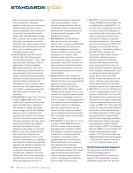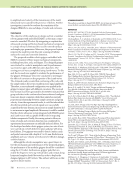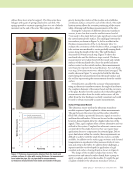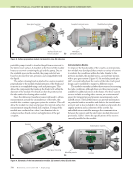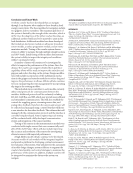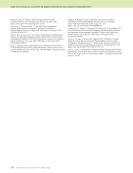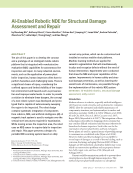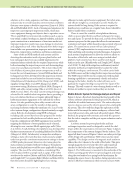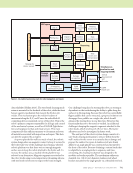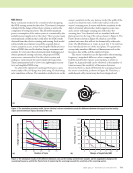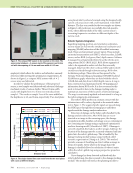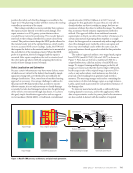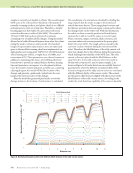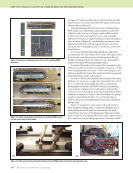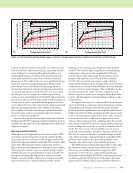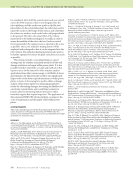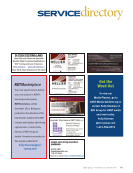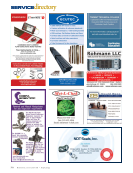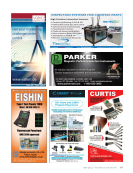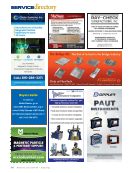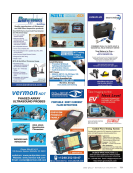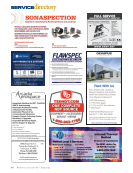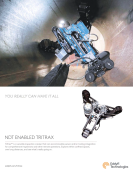680 M A T E R I A L S E V A L U A T I O N • J U L Y 2 0 2 1 ME FEATURE w automated robotic systems for aerospace ndt Introduction Robots offer versatility beyond the traditional gantry system, which is a large metal frame structure with a bridge attachment. For example, longer aerospace parts are dealt with by simply installing additional robot track, which can be shimmed and bolted in most circumstances. A variety of part configurations can be handled with different end of arm tools (EOATs) that the robot can pick up to perform the inspections. In this manner, the NDT software and instrumentation remains the same, and when done properly, path planning software for motion control becomes easily adaptable for different part configurations. Aerospace parts such as wing skins, fuselage sections, and horizontal stabilizers all have contours associated with their part surfaces. These contours are fully represented in their CAD models and can be pulled directly into the robot simulation and programming software. When this is done, the Cartesian coordinate (X, Y, Z) of the contoured part surface is mapped to the 3D coordinate system of the simulator. This is needed for verification of part coverage and robot axis behavior as well as collision avoidance for safety purposes. While the robot with six degrees of freedom is flexible enough to perform NDT on these contoured parts, the system architecture must account for the 3D environment of the robot to provide a 2D C-scan output (Brekow et al. 2014 Munikoti et al. 2012). The 2D C-scan output is well known in the industry for analysis of ultrasonic NDT data and must represent the dimensions of the contoured surface to some reasonable tolerance. The design of the automated robotic system in this paper presents modules created to make an easy progression from a mechanical system with six degrees of freedom to an output display having two dimensions. The C-scan output will be generated from a PAUT instrument inter- faced to the articulated robot. Design of the EOAT and robot path planning is done in such a way as to minimize transformational requirements between the two coordinate systems. System Modularity When designing an automated robotic system for a broad range of NDT applications, it is beneficial to select system modules that offer easy interfacing to external devices. An example is shown in Figure 1. In this instance, there are multiple EOATs used to perform inspections for a broad range of applications (for example, skin panels, stiffeners, or fuselage sections). In addition, the EOATs can employ multiple NDT methods and techniques such as PAUT, laser UT, and thermal/infrared testing (IR). These tools can be easily swapped in and out of the system with the use of mechanical adapter plates located on the tool center point (TCP) or the flange of the robot. Also shown in Figure 1 is a positional triggering module (PTM). This will be discussed later in more detail. The PTM provides electronic pulses to tell the inspection instrument when to collect the NDT data. In this example, the inspection instrument is a PAUT instru- ment using linear array sensors, and the array sensors are designed into the robot EOATs. Why place emphasis on system modularity? Ideally, it is preferred that the robot path planning Six-axis robot with track Programmable logic controller Local positioning system Positional triggering module Inspection instrument Adapter plate Adapter plate Robot tool 2 Adapter plate Robot tool 1 Adapter plate Robot tool 3 Figure 1. System modules for an automated robot system.
J U L Y 2 0 2 1 • M A T E R I A L S E V A L U A T I O N 681 software accommodates different NDT sensors in terms of their resolution and coverage requirements. If an aerospace structure comes into the cell with a minimum radius of 1 m instead of 5 m, this will require a smaller array to maintain ultrasonic coupling along the length of the array. Changing an ultrasonic linear array 100 mm in length to an array 64 mm in length should not require a complete system redesign. The robot path planning software, inspection instru- ment, PTM, and adapter plates should all be able to handle this type of change quite easily. Another reason for system modularity would be having two inspection instruments fed by the same PTM and connected to the same types of adapter plates. The concept of system modularity allows for easy expansion of NDT techniques and easy accommoda- tion of part variations that the automated robotic system can inspect. Adapter Plates and Robot Tools To increase system modularity in an automated robotic system, the use of adapter plates is adopted. Adapter plates are used to swap EOATs on and off the robot. Since these EOATs are used for NDT, they will be referred to as “NDT tools” for the purpose of this paper. A picture of an adapter plate is shown in Figure 2. Adapter plates can be thought of as mechan- ical connectors where one male connector is attached to the flange of the robot and the corresponding female connector is attached to the NDT tool. There is usually a collision sensor between the NDT tool and the adapter plate, as shown in Figure 2. The adapter plates allow for water throughput to ultrasonic sensors, pneumatic throughput to linear actuators, Ethernet connections, electrical connections, and the like. When designed properly, the same adapter plate attached to the robot flange can pick up many different NDT tools (such as test hardware for IR, laser UT, and PAUT). Figure 3 shows an example of an NDT tool used to inspect skin panels using a single ultrasonic array sensor (Fetzer et al. 2014). The ultrasonic array is coupled to the PAUT instrument residing on the robot Collision sensor Water and pneumatic ports Figure 2. Robot adapter plate used to couple and pick up the NDT tool. This adapter plate is used to pick up a skin panel stiffener NDT tool. Collision sensor Linear actuator Ultrasonic array probe Figure 3. Skin panel NDT tool used to inspect either flat or slightly curved composite panels. The concept of system modularity allows for easy expansion of NDT techniques and easy accommodation of part variations...
ASNT grants non-exclusive, non-transferable license of this material to . All rights reserved. © ASNT 2025. To report unauthorized use, contact: customersupport@asnt.org



























































